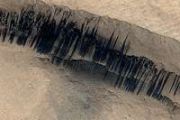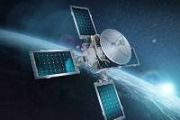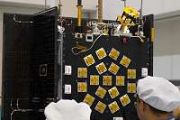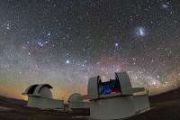
Copernical Team
NASA picks next 4 crew members for simulated Mars mission in Texas
 The third volunteer research team to participate in NASA's simulated mission to Mars has been picked as the United States aims to better understand how humans will react during a deep-space mission, the space agency said Monday.
Erin Anderson, Sergii Iakymov, Brandon Kent and Sarah Elizabeth McCandless are to begin their simulated trek to Mars within NASA's Human Exploration Research An
The third volunteer research team to participate in NASA's simulated mission to Mars has been picked as the United States aims to better understand how humans will react during a deep-space mission, the space agency said Monday.
Erin Anderson, Sergii Iakymov, Brandon Kent and Sarah Elizabeth McCandless are to begin their simulated trek to Mars within NASA's Human Exploration Research An Queen's University Belfast Researchers Investigate Mysterious Brightening of Chiron
 Planetary astronomers at Queen's University Belfast have delved into one of the Solar System's enduring enigmas: the unusual behavior of Chiron.
Discovered in 1977 and initially classified as an asteroid, Chiron was the first recognized member of the Centaurs, a new class of Solar System objects. The Centaurs inhabit short-lived orbits between the asteroid belt and the Kuiper belt, a dista
Planetary astronomers at Queen's University Belfast have delved into one of the Solar System's enduring enigmas: the unusual behavior of Chiron.
Discovered in 1977 and initially classified as an asteroid, Chiron was the first recognized member of the Centaurs, a new class of Solar System objects. The Centaurs inhabit short-lived orbits between the asteroid belt and the Kuiper belt, a dista Deep-Ocean Minerals Generate Oxygen at 13,000 Feet Below Surface
 An international team of researchers, including a chemist from Northwestern University, has discovered that metallic minerals on the deep-ocean floor can produce oxygen at depths of 13,000 feet.
This finding challenges the traditional belief that only photosynthetic organisms, such as plants and algae, generate Earth's oxygen. The discovery suggests oxygen can also be produced at the seafl
An international team of researchers, including a chemist from Northwestern University, has discovered that metallic minerals on the deep-ocean floor can produce oxygen at depths of 13,000 feet.
This finding challenges the traditional belief that only photosynthetic organisms, such as plants and algae, generate Earth's oxygen. The discovery suggests oxygen can also be produced at the seafl New Magnetic Criteria Suggest Only Two Exoplanets Potentially Habitable
 Interest in Earth-like planets within the habitable zone of their stars has surged, driven by the quest to find life beyond our solar system. However, the potential habitability of such planets, known as exoplanets, depends on more than just their distance from the star.
A new study by Rice University's David Alexander and Anthony Atkinson broadens the definition of a habitable zone to inc
Interest in Earth-like planets within the habitable zone of their stars has surged, driven by the quest to find life beyond our solar system. However, the potential habitability of such planets, known as exoplanets, depends on more than just their distance from the star.
A new study by Rice University's David Alexander and Anthony Atkinson broadens the definition of a habitable zone to inc Quantum Particles Energy Landscape Theory Unveiled by Physicists
 An international team of physicists, based at Trinity College Dublin, has formulated new theorems in quantum mechanics that define the "energy landscapes" of quantum particle collections. This work addresses long-standing questions, paving the way for more accurate computer simulations of materials, which could aid in developing new green technologies.
The theorems, recently published in t
An international team of physicists, based at Trinity College Dublin, has formulated new theorems in quantum mechanics that define the "energy landscapes" of quantum particle collections. This work addresses long-standing questions, paving the way for more accurate computer simulations of materials, which could aid in developing new green technologies.
The theorems, recently published in t New Insight into Supermassive Black Hole Mergers and Dark Matter
 Researchers have identified a crucial link between supermassive black holes (SMBHs) and dark matter particles, shedding light on the "final parsec problem" in astrophysics.
New calculations suggest that the merger of SMBH pairs into a single entity is facilitated by the previously underestimated behavior of dark matter particles. This discovery offers a potential solution to the "final par
Researchers have identified a crucial link between supermassive black holes (SMBHs) and dark matter particles, shedding light on the "final parsec problem" in astrophysics.
New calculations suggest that the merger of SMBH pairs into a single entity is facilitated by the previously underestimated behavior of dark matter particles. This discovery offers a potential solution to the "final par Astroscale UK Wins Contract for Final Phase of ELSA-M Demonstration
 Astroscale Ltd ("Astroscale UK"), a subsidiary of Astroscale Holdings Inc. ("Astroscale"), has secured EUR 13.95 million (approximately USD 15 million or GBP 11.78 million) from the UK Space Agency and the European Space Agency ("ESA") for the final phase of the End-of-Life by Astroscale-Multiple (ELSA-M) in-orbit demonstration.
The funding follows a contract with Eutelsat OneWeb as part o
Astroscale Ltd ("Astroscale UK"), a subsidiary of Astroscale Holdings Inc. ("Astroscale"), has secured EUR 13.95 million (approximately USD 15 million or GBP 11.78 million) from the UK Space Agency and the European Space Agency ("ESA") for the final phase of the End-of-Life by Astroscale-Multiple (ELSA-M) in-orbit demonstration.
The funding follows a contract with Eutelsat OneWeb as part o Expiring medications could pose challenge on long space missions

Medications used by astronauts on the International Space Station might not be good enough for a three-year journey to Mars. A new study led by Duke Health shows that over half of the medicines stocked in space—staples such as pain relievers, antibiotics, allergy medicines, and sleep aids—would expire before astronauts could return to Earth.
Astronauts could end up relying on ineffective or even harmful drugs, according to the study appearing July 23 in npj Microgravity.
"It doesn't necessarily mean the medicines won't work, but in the same way you shouldn't take expired medications you have lying around at home, space exploration agencies will need to plan on expired medications being less effective," said senior study author Daniel Buckland, M.D., Ph.D., an assistant professor of emergency medicine at Duke University School of Medicine and an aerospace medicine researcher.
Expired medications can lose their strength by a little—or a lot. The actual stability and potency of medications in space compared to Earth remain largely unknown. The harsh space environment, including radiation, could reduce the effectiveness of medications.
Buckland and co-author Thomas E.
NASA's Artemis II moon mission rocket core stage on way to Kennedy Space Center
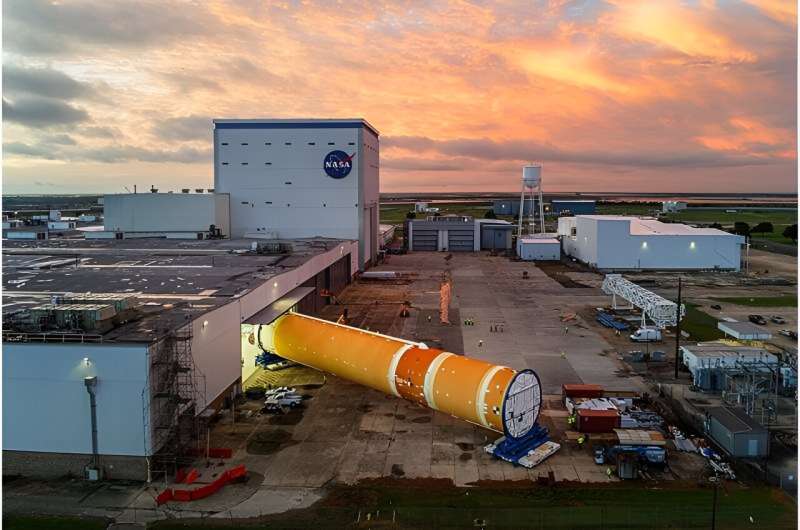
The biggest piece of the puzzle to send humans on a trip around the moon for the first time in more than half a century is on its way to Kennedy Space Center.
The Boeing-built core stage of NASA's Space Launch System rocket was loaded onto NASA's Pegasus barge from the Michoud Assembly Facility in New Orleans, and is now taking the 900-mile trip to Florida.
The flight hardware that includes the four RS-25 engines made by Aerojet Rocketdyne from the space shuttle era will then be taken to the Vehicle Assembly Building where it will be turned upright standing 212 feet tall. It will be married to other components of the SLS rocket including two solid rocket boosters from Northrop Grumman that when combined produce 8.8 million pounds of thrust on liftoff.
The next flight is Artemis II, which is targeting launch from KSC's Launch Pad 39-B no earlier than September 2025. That mission will take NASA astronauts Reid Wiseman, Victor Glover and Christina Koch along with Canadian astronaut Jeremy Hansen on a trip out to the moon and back aboard the Orion spacecraft built by Lockheed Martin.
















